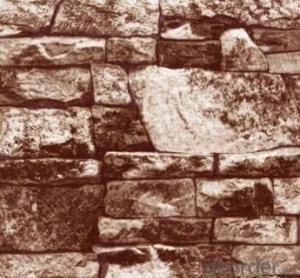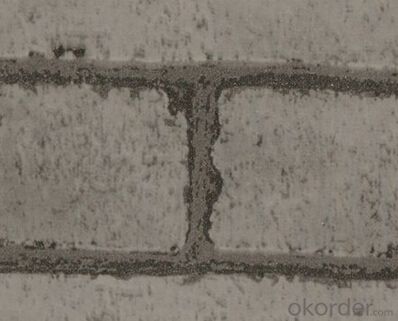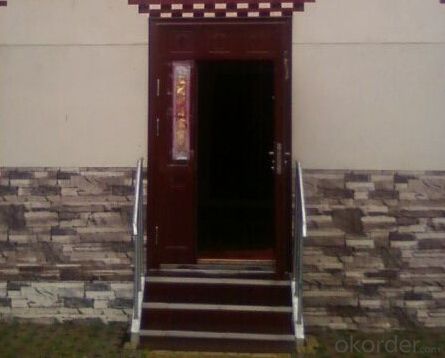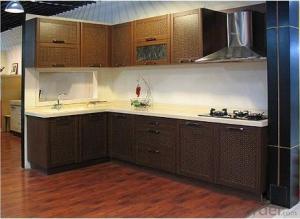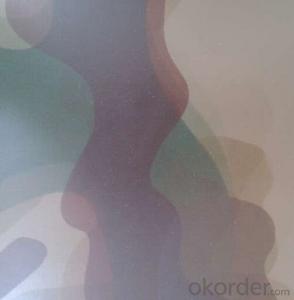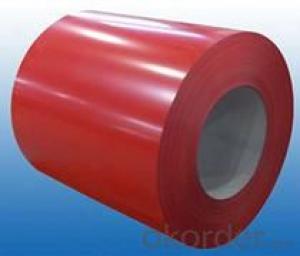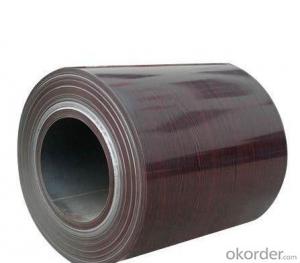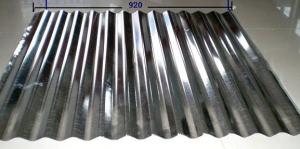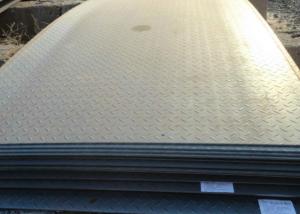Print Prepainted Galvanized Steel Coil Wooden Pattern for Wall
- Loading Port:
- Tianjin
- Payment Terms:
- TT OR LC
- Min Order Qty:
- 12 m.t.
- Supply Capability:
- 1000 m.t./month
OKorder Service Pledge
OKorder Financial Service
You Might Also Like
1.Structure of Print Prepainted Galvanized Steel Coil Wooden Pattern for Wall:
With Gi as base metal,after pretreatmet (degrease and chemical treatment) and liquid dope with several Layers of color,then after firing and cooling,finally the plate steel is called pre-painted galvanized steel ( PPGI) .Pre-painted galvanized steel is good capable of decoration ,molding,corrosion resistance
2.Main Features of Print Prepainted Galvanized Steel Coil Wooden Pattern for Wall:
• Excellent process capability
• Smooth and flat surface
• Workability, durability
• Excellent heat resistance performance
• High strength
• Good formability
• Good visual effect
3.Print Prepainted Galvanized Steel Coil Wooden Pattern for Wall Images

4.Print Prepainted Galvanized Steel Coil Wooden Pattern for Wall Specification
Standard:ASTM, GB,JIS,JIS G3302 ASTM 755 EN10169
Grade: DX51D CGCC CS
Thickness: 0.13mm~3.0mm,
Width: 1250,600-1250mm
Coil weight:3-12 MT
Coil ID:508/610mm
Chemical composition:
C | Si | Mn | Cr | Ni | P | S |
0.150 | 0.476 | 11.231 | 12.50 | 0.900 | 0.039 | 0.010
|
5.FAQ of Print Prepainted Galvanized Steel Coil Wooden Pattern for Wall
We have organized several common questions for our clients,may help you sincerely:
1.How do you control your quality
We have established the international advanced quality management system,every link from raw material to final product we have strict quality test;We resolutely put an end to unqualified products flowing into the market. At the same time, we will provide necessary follow-up service assurance.
2.How long we will receive the goods ?
After receiving your deposit or workable lc ,our normal shipment date is 15-20days,and it takes around 28 days to reach your port of destination. But is up to different destination
3. What is your moq
Normally our moq is 12mt per size ,but it is up to different size.
- Q: Can the steel sheets be used for roofing purposes?
- Yes, steel sheets can be used for roofing purposes. Steel roofing sheets are a popular choice due to their durability, strength, and resistance to harsh weather conditions. They provide excellent protection against elements such as rain, snow, and hail. Steel roofing sheets are also fire-resistant and can withstand high winds, making them a reliable option for roofing. Additionally, steel sheets are lightweight, which makes them easier to install and reduces the load on the structure. They are available in various designs and colors, allowing for customization according to individual preferences. Overall, steel sheets are a versatile and practical choice for roofing purposes.
- Q: What are the safety considerations when working with steel sheets?
- When working with steel sheets, there are several important safety considerations to keep in mind: 1. Personal Protective Equipment (PPE): It is crucial to wear appropriate PPE to protect yourself from potential hazards. This may include safety glasses or goggles, gloves, steel-toed boots, and a hard hat. 2. Lifting and handling: Steel sheets can be heavy and awkward to handle. Use proper lifting techniques, such as bending your knees and keeping your back straight, or use mechanical lifting equipment like cranes or forklifts. Never attempt to lift a sheet that is too heavy for you alone. 3. Slips, trips, and falls: Steel sheets can create slippery surfaces, especially when wet or oily. Keep work areas clean and free of debris, and use non-slip mats or flooring where appropriate. Be cautious of trip hazards, such as cords or tools, and use caution when moving around the work area. 4. Sharp edges and corners: Steel sheets often have sharp edges and corners that can cause cuts or injuries. Use caution when handling and moving them, and wear gloves to protect your hands. If necessary, use edge protectors or file down any sharp edges to reduce the risk of injuries. 5. Fire hazards: Steel sheets can be flammable when exposed to high temperatures or sparks. Ensure that work areas are clear of flammable materials and follow proper fire safety procedures, such as having fire extinguishers readily available and knowing how to use them. 6. Noise and vibration: Working with steel sheets can generate significant noise and vibration. Wear ear protection, such as earplugs or earmuffs, to protect your hearing. If using power tools, ensure they are properly maintained and have vibration-dampening features to minimize the risk of hand-arm vibration syndrome. 7. Adequate ventilation: Some steel sheets may release fumes or dust when cut or welded. Ensure that the workspace is well-ventilated to prevent the accumulation of harmful gases or particles. If necessary, use exhaust fans or wear respiratory protection to avoid inhalation of hazardous substances. By following these safety considerations, you can minimize the risks associated with working with steel sheets and create a safer work environment for yourself and others.
- Q: Are steel sheets suitable for automotive exhaust systems?
- Yes, steel sheets are suitable for automotive exhaust systems. Steel is a commonly used material in the manufacturing of exhaust systems due to its durability, strength, and resistance to high temperatures and corrosion. Automotive exhaust systems are subjected to extreme heat and corrosive gases, and steel sheets are able to withstand these conditions effectively. Additionally, steel sheets can be easily formed and welded, making them suitable for the complex shapes and configurations required in exhaust system components. Overall, steel sheets provide the necessary properties and characteristics required for automotive exhaust systems, making them a suitable choice for this application.
- Q: How do steel sheets compare to other materials, such as aluminum or stainless steel?
- Steel sheets have their own unique properties and advantages that set them apart from other materials such as aluminum or stainless steel. Compared to aluminum, steel sheets are generally stronger and more durable, making them suitable for applications that require high strength and resistance to wear and tear. Stainless steel, on the other hand, offers excellent corrosion resistance, making it ideal for applications in harsh environments. Ultimately, the choice between steel sheets, aluminum, or stainless steel depends on the specific requirements of the project or application at hand.
- Q: How do steel sheets perform in terms of weather resistance?
- Steel sheets are known for their exceptional weather resistance properties. Due to their composition and protective coatings, steel sheets are highly resistant to various weather conditions such as rain, snow, and wind. They have the ability to withstand extreme temperatures, both hot and cold, without any significant deterioration or damage. Additionally, steel sheets are also highly resistant to corrosion, making them an ideal choice for outdoor applications and areas with high humidity or saltwater exposure. The weather resistance of steel sheets helps to ensure their longevity and durability, making them a reliable option for various construction and industrial purposes.
- Q: Are steel sheets suitable for manufacturing elevator doors?
- Steel sheets are indeed appropriate for the production of elevator doors. The strength, durability, and aesthetic charm of steel make it a popular preference for elevator doors. Steel sheets possess the essential strength and rigidity needed for elevator doors, ensuring safety and security. Furthermore, steel is resistant to wear and tear, corrosion, and fire, rendering it a dependable material for elevator doors. Steel sheets can also be easily tailored and completed to meet diverse design specifications, granting a wide array of styles and finishes. In conclusion, steel sheets possess the necessary attributes for the manufacturing of elevator doors, making them a fitting selection for this purpose.
- Q: How do steel sheets compare to other materials like aluminum or copper?
- There are numerous advantages to using steel sheets over materials such as aluminum or copper. Firstly, steel is significantly stronger and more durable than both aluminum and copper. This makes steel sheets perfect for applications that require high strength and the ability to resist wear and tear, such as construction, automotive manufacturing, and industrial machinery. Secondly, steel sheets have a higher melting point than aluminum and copper. As a result, steel can withstand higher temperatures without deforming or melting, making it suitable for applications involving exposure to high heat or fire. Additionally, steel sheets are more cost-effective than both aluminum and copper. Steel is readily available and relatively inexpensive compared to these other materials. This makes steel sheets a more economical choice for large-scale applications that require a substantial amount of material. Furthermore, when properly coated or treated, steel sheets have excellent corrosion resistance properties. In contrast, aluminum and copper are more susceptible to corrosion and require additional protective measures. This makes steel sheets a superior choice for outdoor or marine applications where exposure to moisture and harsh environments is a concern. Lastly, steel sheets are highly recyclable, making them a more sustainable choice compared to aluminum and copper. Steel is one of the most recycled materials globally, with a recycling rate of nearly 90%. This reduces the environmental impact and conserves natural resources. In summary, steel sheets offer exceptional strength, durability, heat resistance, cost-effectiveness, corrosion resistance, and recyclability compared to materials like aluminum or copper. These qualities make steel sheets a versatile and reliable choice for a wide range of applications across various industries.
- Q: Can steel sheets be used for metal fencing?
- Yes, steel sheets can be used for metal fencing. Steel sheets are commonly used in the construction of metal fences due to their durability, strength, and ability to withstand harsh weather conditions. They provide a solid and secure barrier, making them an excellent choice for fencing applications.
- Q: How do you remove stains or marks from steel sheets?
- There are several methods to remove stains or marks from steel sheets. One common approach is to use a mild detergent or soap mixed with warm water, followed by gentle scrubbing using a non-abrasive sponge or cloth. For tougher stains, a mixture of vinegar and water can be effective. Another option is to use a specialized stainless steel cleaner or polish, applying it with a soft cloth and following the instructions provided. It's important to avoid using harsh chemicals or abrasive materials that could damage the steel surface.
- Q: What are the different types of steel sheet finishes?
- There are several different types of steel sheet finishes that serve various purposes and provide different aesthetics. Some of the common types include: 1. Hot Rolled: This finish is achieved by heating the steel sheet above its recrystallization temperature and then rolling it to the desired thickness. It has a rough and textured surface, making it suitable for applications where appearance is not a priority. 2. Cold Rolled: After the hot rolling process, the steel sheet is passed through rollers at room temperature to achieve a smooth and polished finish. Cold rolled finishes are often used in applications that require a superior surface finish, such as automotive panels or appliances. 3. Galvanized: In this process, the steel sheet is coated with a layer of zinc to provide corrosion resistance. The zinc coating also gives the sheet a shiny and reflective appearance. Galvanized finishes are commonly used in outdoor applications to protect against rust and harsh weather conditions. 4. Stainless Steel: This finish is achieved by adding chromium to the steel sheet, which provides excellent corrosion resistance and a sleek, reflective surface. Stainless steel finishes are widely used in kitchen appliances, architectural applications, and medical equipment, where hygiene and durability are essential. 5. Coated Finishes: Steel sheets can be coated with various materials, such as paint, epoxy, or polymer, to enhance their appearance or provide additional protection. Coated finishes can be customized to meet specific requirements, such as color or texture, and are often used in architectural and decorative applications. 6. Brushed: This finish is obtained by brushing the steel sheet with abrasive material, creating a textured and matte surface. Brushed finishes are commonly used in interior design and furniture manufacturing, where a contemporary and stylish appearance is desired. These are just a few examples of the different types of steel sheet finishes available. The choice of finish depends on the specific requirements of the application, such as corrosion resistance, aesthetic appeal, or surface texture.
Send your message to us
Print Prepainted Galvanized Steel Coil Wooden Pattern for Wall
- Loading Port:
- Tianjin
- Payment Terms:
- TT OR LC
- Min Order Qty:
- 12 m.t.
- Supply Capability:
- 1000 m.t./month
OKorder Service Pledge
OKorder Financial Service
Similar products
Hot products
Hot Searches
Related keywords
